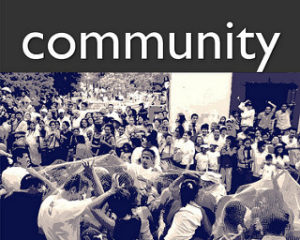 As part of the community engagement planning process virtually every arts organization has to make choices about which communities they want to seek out as partners. (We are talking here about new communities. Current stakeholders should, of course, be the first community with which to engage more fully.) In almost every circumstance it has been my practice to recommend minimizing the “degrees of separation.” That is, go first to communities with which some relationship–through prior programming or through board, staff, or volunteer connections–already exists. This is far simpler, more organic, and less invasive than “cold calling” on a new community.
As part of the community engagement planning process virtually every arts organization has to make choices about which communities they want to seek out as partners. (We are talking here about new communities. Current stakeholders should, of course, be the first community with which to engage more fully.) In almost every circumstance it has been my practice to recommend minimizing the “degrees of separation.” That is, go first to communities with which some relationship–through prior programming or through board, staff, or volunteer connections–already exists. This is far simpler, more organic, and less invasive than “cold calling” on a new community.
However, in several conversations with engagement staff members during the last year I have come to realize that there are circumstances in which that advice needs to be tempered. The demographics of our cities, suburbs, towns, and rural areas are changing rapidly and, in some locales, new communities are becoming so important that engaging with them will be an existential imperative. If we don’t have relationships with them–many, deep relationships–our viability is questionable, sometimes in the near term. So, even if we don’t have any near contact, it is vital to begin the relationship-building process.
Doing so is extremely difficult. There is a very real possibility that communities with which we have no relationship will see such overtures as self-serving on the part of the organization–simple efforts to sell tickets or secure donations. The reactions can range from apathy to hostility. This is why I’ve advocated for first pursuing more closely related groups.
However, in some cases, as for instance where Hispanic/Latino populations are becoming majorities or near majorities, lack of relationships with those communities will inevitably lead the arts organization to become an irrelevant afterthought in shaping the future.
If there is no existing relationship with such a community on which to build, it is still essential to begin. [Of course, if there is no existing relationship, there are issues that are even deeper than “mere” engagement. Why is there no connection with a rapidly growing, vitally important community? But that is a much bigger question than that addressed here.] Regardless, the process will be an extremely long and delicate one, but it must be begun.
Find guides, ambassadors, people to provide introductions. Listen, learn with humility and respect. And don’t expect instantaneous results. This will take much time to bear fruit. But it’s critical to the future of the organization.
Engage!
Doug
Photo: ![]()
![]() Some rights reserved by planeta
Some rights reserved by planeta
